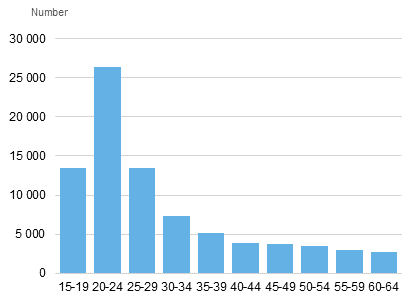Published: 5 March 2015
Around 83,000 employees have zero-hour contracts
In 2014, on average around 83,000 Finnish employees aged between 15 and 64 worked on so-called zero-hour contracts. This was four per cent of all employees. Here, a zero-hour contract refers to an employment contract where the minimum number of working hours is zero. Information about persons working on zero-hour contracts was collected for the first time last year in connection with Statistics Finland’s Labour Force Survey.
Around 83,000 employees aged between 15 and 64 reported that they worked on zero-hour contracts. A majority of them, or 57 per cent were women. The proportion of men was 43 per cent. In 2014, there were 47,000 women and 36,000 men working on zero-hour contracts.
Those who worked on zero-hour contracts were mainly young: nearly one-half were aged under 25, and 65 per cent were aged under 30.
Persons working on zero-hour contracts by age in 2014¹

¹The number of respondents is low in the 40 to 44-year-old age group and older age groups.
Zero-hour contracts were most common among persons aged 15 to 19. Twenty per cent of employees in this age group worked on zero-hour contracts. The share of employees working on zero-hour contracts among those aged 20 to 24 was 14 per cent, and six per cent among those aged 25 to 29. In older age groups, the relative share of employees working on zero-hour contracts was a couple of per cent of the employees in the age group.
Typically, people working on zero-hour contracts are working part-time
Sixty-eight per cent of the employees working on zero-hour contracts reported that they were working part-time in 2014. Thirty-two per cent were working full-time.
The average usual weekly working hours of everyone working on zero-hour contracts was 23 hours per week. The average usual weekly working hours of those working part-time was 15 hours per week and for those working full-time it was 37 hours per week.
A person working on a zero-hour contract can have either a fixed-term employment contract or one valid until further notice. A majority, 72 per cent had an employment contract valid until further notice. Correspondingly, 28 per cent had a fixed-term employment contract. Data concerning the nature of the employment relationships are based on the respondent's own reporting.
The biggest number of persons working on zero-hour contracts were found in wholesale and retail trade (15,000), human health and social work activities (11,000), and accommodation and food service activities (10,000). Relative to the number of employees in the industry, zero-hour contracts were most common in accommodation and food service activities. Thirteen per cent of employees in this industry had zero-hour contracts.
The commonest occupations for persons working on zero-hour contracts based on the Classification of Occupations were sales workers, personal care workers, and personal service workers.
Over one-half (55 per cent) of all persons working on zero-hour contracts reported that their main activity was gainful employment. The second largest group (38 per cent) are those who reported studying as their main activity.
The number of persons working on zero-hour contracts was surveyed in connection with the Labour Force Survey in 2014 with the question: "Is your employment contract a so-called zero-hour contract where the agreed number of working hours is at the minimum zero hours (e.g. 0 to 29 hours per week)?" The question only concerned the main job. Data are based on the respondent's own reporting. Data on the number of persons working on zero-hour contracts are an annual average. Read more from our blog .
Source: Labour Force Survey 2014. Statistics Finland
Inquiries: Anna Pärnänen 029 551 3795, tyovoimatutkimus@stat.fi
Director in charge: Riitta Harala
Publication in pdf-format (283.8 kB)
- Tables
-
Tables in databases
Pick the data you need into tables, view the data as graphs, or download the data for your use.
- Quality descriptions
-
- Quality Description: Labour force survey (5.3.2015)
Updated 5.3.2015
Official Statistics of Finland (OSF):
Labour force survey [e-publication].
ISSN=1798-7857. Employment and unemployment 2014. Helsinki: Statistics Finland [referred: 10.12.2025].
Access method: http://stat.fi/til/tyti/2014/13/tyti_2014_13_2015-03-05_tie_001_en.html

